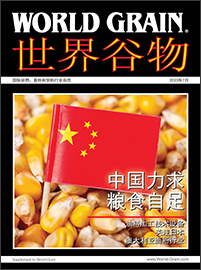ZANZIBAR, TANZANIA — A global economic and trading reset is underway fueled by war in Ukraine, extreme weather events, macroeconomic turmoil and growing geopolitical tensions. With market chaos the norm and forecasting shrouded in question marks, this is throwing up unique challenges for all grain sector stakeholders, said Dan Basse, president and founder of Chicago, Illinois, US-based AgResource Company.
Basse moderated multiple sessions at the 32nd Annual International Association of Operative Millers (IAOM) Mideast & Africa Conference and Expo held Oct. 25-28 in Zanzibar, Tanzania. Speaking exclusively to World Grain, he outlined the key drivers of the volatility facing the grain industry, and the risks and opportunities that lie ahead.
Turning to current economic turmoil, Basse said growing European, US and global inflationary pressures had prompted central banks to hike interest rates. This “Great Economic Reset,” as he called it, had brought to an end the days of low interest rates and quantitative easing. However, he said it remained unclear what the new natural rate of inflation would be. This was creating investment uncertainty across industries, pushing up the cost of capital and throwing equity, commodity and currency markets into disarray.
Basse is also bearish on the overall global demand outlook and expects underinvestment in energy to continue to impact input prices for agricultural sectors. As a result, AgResource Company has been downgrading its trade numbers in line with this “Reset.”
“We’ve been taking down our (2022-23) world trade and our world consumption numbers about 6% globally in wheat, maybe down 4.5% to 5% in corn, off 4% in soybeans etc.,” he said. “So, world demand is coming down and world trade will be more impacted. It’s just a tough world in terms of getting financing and then the volatility of the markets, both in the financials and otherwise, is just giving real angst to the buyers of the world.”
War fog
Russia’s invasion of Ukraine in February, and the ongoing war and humanitarian disaster that is blighting the Black Sea region, is, of course, also casting a long shadow over the geopolitical and trading landscape. There are now huge question marks over the ability of Ukraine’s farmers to provide meaningful supplies to global markets, not least while Russian President Vladimir Putin continues to threaten to close the Black Sea grain corridor that opened for grain exports during the summer of 2022.
“Ukrainian exports are going to be cut about 40% (in the 2022-23 crop year) by our estimates,” Basse said. “We don’t know if Putin’s going to allow the corridor to continue out of the three previously blocked Black Sea grain ports. But let’s assume that Ukraine can get about 2.5 million tonnes of grain out of its far west into Europe. That’s around 40% of pre-war (volumes).”
The long-term hit to grain supplies could be even more severe. Ukrainian farm equipment, infrastructure and even the farmland itself in some southern regions that have been bombed have been damaged by the invasion.
But there is going to be a hole in the world wheat market with Ukrainian supplies absent, no matter whether the war’s ongoing or not ongoing as we look forward to 2023 and 2024.- Dan Basse, president, AgResource
“Ukrainian farmers are now struggling financially,” Basse said. “They don’t have the seed, the fertilizer, the equipment or the financing to plant additional crops going forward. They will probably cut winter wheat seedings by 40% to 45% by our estimates this year in the hope that maybe the war will be over with by spring planting next year. And then they’ll plant corn or sunflowers to supplant what they lost in wheat. But there is going to be a hole in the world wheat market with Ukrainian supplies absent, no matter whether the war’s ongoing or not ongoing as we look forward to 2023 and 2024.”
Even once the war ends, it will take Ukraine a long time to rebuild its grains export industry.
“There’s a six-to-nine-month period, maybe a year, to rebuild, but the infrastructure will take far longer,” Basse said.
All of which builds in costs for Ukrainian exporters, both now and in the future.
“To get a bushel of wheat or corn to the ports today is a little under $5 a bushel,” Basse explained. “So, if you’re a Ukrainian farmer and you think about transporting from Central Ukraine to the port, that’s an expensive price. So, there’s no margin for the farmer. He’s going to hold onto as much grain as he can, and exports are going to be diminished because he always has hope in the future in his main asset to hold onto at the moment, which is going to be grain in the bin.”
Biggest grain shock since WWI
Given that the Black Sea accounts for 12% of the world’s annual intake of grain on a calorific basis, and that sanctions also are impacting Russian exports, Basse called the invasion along with a series of regional droughts the “biggest global grain supply chain shock since the First World War in 1914, 108 years ago.”
On top of soaring inflation and energy prices, many buyers simply cannot afford to import grains in the same volumes as they did previously.
“World trade in the first quarter of the crop year, which runs from July through September, was down about 19%,” Basse said. “So, the world’s trying to get by with less grain. Prices are high, the dollar is high, macroeconomic headwinds are strong. We are worried about export demand in a general sense going forward.”
Fertilizer clouds
The agriculture industry also is facing another major input challenge related to Russia’s invasion of Ukraine in the shape of the impact this has had on global fertilizer prices and availability, not least because exports from the Black Sea are down 18% to 19% this year, said Basse. The result is mayhem and price inflation in fertilizer markets.
“Supplies of fertilizer are going to stay tight and prices are staying high,” he added.
The upshot of all these global forces on US agriculture and exports is proving severe, particularly as the greenback’s strength weakens the competitiveness of US exports.
“Only China is continuing to buy soybean imports, but even this is no longer a growing market, although its hog herd is showing margin profitability,” he said. “That is giving the farmers some ability there to buy soybean meal and help out that import program to China. Short of that, there’s not much optimism.
“Europe is going to be the largest importer of corn from last year’s drought, but prices are high and the euro is low. It’s not a favorable time to be involved in Europe, and we’re seeing livestock liquidation elevated because of that.”
US anxiety grows
AgResource Company’s Rural America anxiety index has plunged this year.
“Their worry is high prices for grain inputs like fertilizer, chemicals and seed — everything is going up,” Basse said.
And at the same time, they need a high grain price to break even, and the markets are shaky. They don’t know when the Ukrainian-Russian war will end. South America looks like it’s on the doorstep of producing a record large soybean crop. With that in mind, they’re very anxious about their futures.
“This is something they’ve never had to navigate in terms of the volatility of the markets and what they’re looking at in terms of profitability,” he said. “But net farm income will be down in the year ahead, which is something you wouldn’t imagine with prices as high as they are.”
Water levels on the Mississippi River at near decade lows are adding more complexity and cost into the logistics of exporting US grains and importing fertilizer, added Basse.
The US-China relationship also continues to add uncertainty to markets, with the US-China trade war now being overshadowed by deeper political concerns, not least over Taiwan, as well as President Xi’s zero-COVID policies that have dampened economic growth and demand forecasts and disrupted supply chains.
Basse said the Biden administration had failed to build on the trade rapprochement of the latter Trump years when China returned to US markets as a serious buyer.
“China and the US are not on a good political footing and it’s going to damage trade increasingly as we look forward,” Basse said. “I think the Chinese, based on all of this saber-rattling that the US is doing politically-speaking, will try to secure as many ag products as it can away from the US. China’s now getting ready, probably in December, to approve Brazilian corn. We think that the Chinese will become a sizeable importer of Brazilian corn going forward. So, US exports are somewhat in trouble looking forward.”
He also said China’s imports of soybeans were another factor for global markets to factor in.
“China’s soybean imports have stagnated now for quite a few years,” he said. “China used to be the big growth engine of world agricultural demand. The diminished GDP forecast growth in China will weigh heavily on that as well.”
The case for optimism
As for forward optimism, Basse does not see much room for economic improvement in the short term.
“I don’t see any change,” he said. “I think that the US central bank’s going to keep raising rates. Inflation is not under control. And we see it at AgResource being very sticky. We think that the world will be plunging into some kind of recession of a severity as yet to be determined by future central bank rate hikes. It’s going to be damaging demand in a lot of areas.”
Asked what needs to happen to pull agricultural markets out of the current supply crunch, Basse said a switch from La Niña to El Niño weather systems would help boost global grain supply from the Americas.
“Over time, then we could maybe mend the supply shortages,” he added. “What we don’t know about is the war. I can’t even tell you if the Black Sea corridor is going to stay open. But that will play big in the longer-term outlook because you know, initially the markets will decline when the war is over, but then they’ll understand that we need to build back infrastructure.
“There’s a lot of things that need to happen before regularity returns to Ukraine and to grain markets.”
Michael King is a multi-award-winning journalist and podcaster as well as a shipping and logistics consultant. He also supplies an array of corporate services. For more information, email mikeking121@gmail.com.





